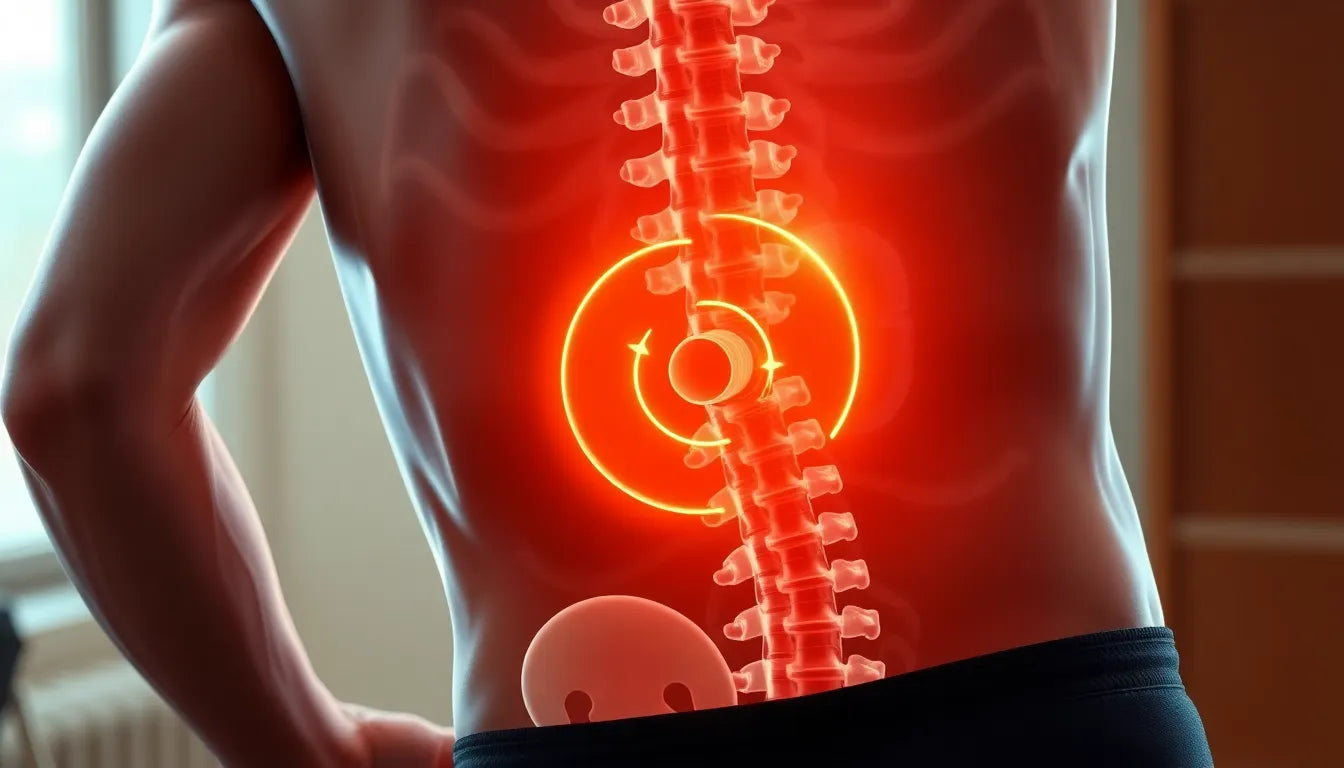Back pain is a common ailment that affects many people at various stages of life, often caused by a condition known as a herniated disc. But what exactly is a herniated disc, and how does a herniated disc feel? Understanding the basics of this condition can help you recognize its symptoms early and seek appropriate care.
Understanding the basics of a herniated disc
A herniated disc occurs when the soft, jelly-like center of a spinal disc pushes through a crack in the tougher exterior casing. This can happen anywhere along the spine but is most common in the lower back, or lumbar region. The resulting pressure on nearby nerves can cause pain, numbness, or weakness in an arm or leg. Given how integral our spine is to daily movement, the impact of a herniated disc can be significant, affecting everything from mobility to overall comfort.
Back pain is a prevalent issue in modern society, with countless individuals experiencing some form of discomfort throughout their lives. Understanding the sensations associated with a herniated disc is crucial, not only for diagnosis but also for effective management. By learning to listen to your body and interpret these signals, you can better navigate your path to recovery.
The importance of recognizing symptoms early
Recognizing the symptoms of a herniated disc early can make a substantial difference in your quality of life. This condition can lead to considerable pain and discomfort, impacting your ability to perform everyday tasks. Early detection is key to preventing further complications and improving treatment outcomes. By being aware of the signs, you can take proactive steps to address the issue before it escalates.
Common symptoms of a herniated disc include sharp, shooting pains, often described as burning or electric shock-like sensations. These can worsen with activities that increase spinal pressure, such as sitting, standing, or sneezing. Relief is often found when lying down or changing positions. Additionally, the location of the pain can vary depending on where the disc herniation occurs, affecting different parts of the body.
In conclusion, understanding how a herniated disc feels and recognizing its symptoms early is essential for maintaining your health and well-being. By paying attention to your body's signals and seeking medical advice when needed, you can effectively manage the condition and minimize its impact on your life.
common sensations and symptoms of a herniated disc
Experiencing a herniated disc can be a daunting ordeal, marked by a variety of sensations that can significantly affect daily life. Understanding these sensations is crucial for identifying the condition and seeking appropriate care. One of the most common symptoms is pain, which is often described as sharp or shooting. Many people liken it to a burning or electric shock-like sensation, particularly when the pain radiates into the limbs. This discomfort is typically exacerbated by activities that increase spinal pressure, such as sitting, standing, or sudden movements like sneezing. Conversely, relief is often found when lying down or changing positions.
pain location based on disc location
The location of the pain largely depends on where the herniation occurs along the spine. In the lumbar region, or lower back, pain often radiates from the buttocks down the thigh, calf, and sometimes into the foot. This phenomenon is commonly referred to as sciatica and typically affects only one side of the body. In the cervical region, or neck, individuals may experience pain that extends from the neck, between the shoulder blades, and down the arms into the hands or fingers. This pain is often aggravated by neck movements. Although less common, herniated discs in the thoracic region, or mid-back, may cause pain in the middle back or around the rib cage. In severe cases, this can affect gait and leg strength.
associated symptoms of a herniated disc
In addition to pain, a herniated disc can produce several other symptoms that impact daily functioning. Numbness and tingling in the affected areas, such as the leg, foot, arm, or hand, are frequent complaints. Muscle weakness is another significant symptom, potentially leading to stumbling or difficulty gripping or lifting objects. In severe instances, the condition may result in a loss of reflexes or, rarely, bowel or bladder dysfunction, which constitutes a medical emergency.
understanding variability in symptoms
It's important to note that not all herniated discs cause noticeable symptoms. Some individuals may have a herniated disc without any pain or discomfort, discovering the condition only through imaging tests conducted for other reasons. This variability often depends on whether the herniation compresses nearby nerves. Nerve-compressive herniated discs are more likely to produce the painful, radiating symptoms described, whereas non-compressive herniated discs might result in milder, duller pain or be entirely asymptomatic.
Understanding how a herniated disc feels can empower individuals to seek timely medical intervention and adopt strategies to manage their symptoms effectively. By recognizing the common sensations and symptoms, you can better navigate the challenges posed by this condition and work towards maintaining your quality of life.
Comparative analysis of pain from a herniated disc
Understanding the differences in pain and symptoms based on the location of a herniated disc is crucial for effective management. The table below highlights the primary sensations and their impacts on daily activities, depending on whether the herniation is in the lumbar, cervical, or thoracic region.
| Spinal Region | Common Sensations | Impact on Daily Activities |
|---|---|---|
| Lumbar (Lower Back) | Sciatica, sharp or shooting pain, numbness | Difficulty sitting, standing, or walking for extended periods |
| Cervical (Neck) | Neck pain, radiating pain to arms, tingling | Challenges with neck movements, affecting tasks like driving or reading |
| Thoracic (Mid-Back) | Mid-back pain, possible rib cage discomfort | Limited torso movement, affecting posture and breathing |
Patient stories and real-world experiences
Real-world experiences can provide valuable insights into living with a herniated disc. One patient, a 45-year-old office worker, described her lumbar disc pain as "a constant, burning sensation that shoots down my leg, making it hard to sit at my desk for long periods." Another individual, a 30-year-old athlete, compared cervical disc discomfort to "a sharp, electric shock that runs from my neck to my fingertips whenever I move my head." These vivid descriptions help illustrate the diverse experiences of those affected by herniated discs.
The role of ergonomic aids in managing herniated disc symptoms
Ergonomic aids can play a significant role in alleviating the discomfort associated with a herniated disc. Items such as lumbar support cushions, ergonomic chairs, and adjustable desks can help reduce spinal pressure and promote proper posture. These aids are particularly beneficial for individuals who spend long hours sitting or performing repetitive tasks, as they can enhance comfort and prevent symptom exacerbation.
Frequently Asked Questions
What are the first signs of a herniated disc?
Early signs of a herniated disc include localized pain, numbness, and tingling, which often worsen with certain movements like bending or twisting.
How is a herniated disc diagnosed?
A herniated disc is typically diagnosed through a combination of a physical examination and imaging tests such as MRI or CT scans to confirm the location and extent of the herniation.
Can a herniated disc heal on its own?
Many herniated discs improve over time with conservative treatments such as rest, physical therapy, and pain management. However, some cases may require medical intervention if symptoms persist or worsen.
When should I see a doctor for back pain?
You should seek medical attention if you experience severe, persistent back pain or if it is accompanied by symptoms like weakness, numbness, or loss of bladder control, as these can indicate a more serious condition.
Are there exercises that can help with a herniated disc?
Yes, specific exercises can strengthen the back and relieve pressure on the spine. It is important to perform these exercises under professional guidance to ensure they are done safely and effectively.
Sources
- Mayo Clinic. "Herniated Disk - Symptoms and Causes."
- Cleveland Clinic. "Herniated Disc."
- StatPearls/NCBI Bookshelf. "Herniated Disc."
- NewYork-Presbyterian. "Herniated Disc Symptoms and Treatments."
- Main Line Spine. "Understanding Herniated Discs."
- Barrow Neurological Institute. "Herniated Disc."
- AANS. "Herniated Disc."



